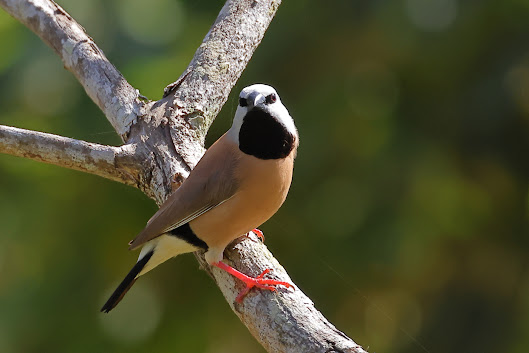Round-up bad, weeds worse! Right?
So let's get the Hi-lux super spray unit out and zap all that hymenachne and pink burr and stuff out of the swamp ricegrass at Tyto. Right?
Wrong! Wrong! Wrong!
See what happens! Weeds say thanks very much and spring up all along the vehicle tracks through the ricegrass. Notice how high the dead grass is. Weeds can't get through from down below. Until the nice spray men come along and flatten the way for them.
Hymenachne and wild tobacco both benefit. So the work to kill hymenachne is now promoting its growth.
And you'll never guess what efforts to remove salvinia and pink lotus from the main lagoon system have achieved. Temporary and ugly death of lotus and the sinking of free-floating salvinia.
Plenty more of both sitting in the mud below (lotus) and at lagoon edge (salvinia). Waiting for the next rains (January, probably, if El Nino allows).
Could be worse. Well, yes and it certainly has been.
Because all that ricegrass was the roosting area for six iconic Eastern Grass Owls, parents and four matured youngsters.
They didn't like the nice spray men driving over the top of their day tunnels and ideal breeding habit. They quit the place.
I've been able to find just one female in past four months.
Bad enough that the failed Wet this year has driven most of several species away to search for wetter breeding places.
But all was made worse when the conditions allowed the nice spray men access to the ricegrass much earlier in the year than usual.
Overall, I think conservation areas are not well served by local bodies with their mindsets of tidy parks, and groundskeeping.
In extension of which, I append a letter submitted to the local bi-weekly paper, and run in it with odd deletion only of dollar figure for Tyto spending. Odd, because the figure came straight from the newspaper. Anyway here 'tis (Sept 6):
Just back from the 'real' Tyto, the original main lagoon wetlands. Ticked 114 bird species in four visits this month. Morning tally on Saturday was 81 species. The numbers show Tyto heads Australia's easy-walking, small public birding spots.
Saturday's Express reveals Tyto Precinct and Wetlands (whatever the combination means) cost $268,000 in financial year 2014-15. Presumably the sum covers maintenance of all grass and tracks and footbridges, hides and lookouts around the main lagoon system. There was also, I think, a farcical wooden walkway on expensive stainless steel footings to pointless wet hole in reeds and more recently an overengineered culvert, plus more plastic bollards (someone's favourite nonsense for years).
So, what's Tyto's problem? Well, there is the $18.75million of ugly steel and concrete out the front. And the silliness of expecting much return from such empire building, the purpose of which was a variation on Keynes' men digging holes and filling them in again to keep economies and communities ticking over. It's all there now. Live with it! Though it would be great if the info centre got a minor makeover to remove the dreadful angled stanchions and hide the mess of aircon atop the roof.
Back to the 'real' Tyto. It continues to draw birders from around the world. It's high among the eight North Queensland hotspots that fill the top 10 for all of Australia.
That $268,000 could be trimmed 50% by reducing track widths, slashing the mostly ineffective spraying and token weed-tree culls, and getting rid of bollard lovers, wherever they rule.
What does the real Tyto need? Decent maps and signage (promised for five years). A hide that actually hides birders and looks onto a clear (not weed-choked) channel. Without any 'help' from the shire it will continue to be a birders' paradise.
The $18.75m other Tyto? No worse than most such. Some even like the prison camp lookout and factory block library (of which I am big user) and art gallery.
Just remember, the real Tyto was there first (saw a female Grass Owl on Saturday) and is the reason for all the rest. Let's put first things first.

























